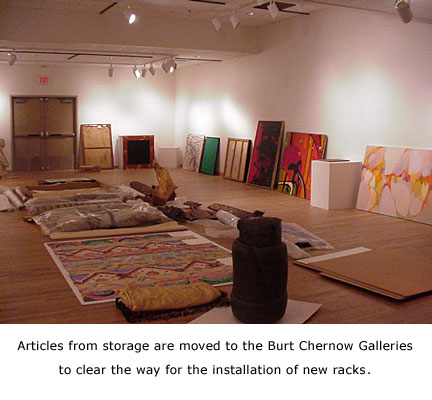Behind the Scenes of a Museum
Follow the progress of the HMA storage renovation and see what goes on behind the scenes to keep the Museum in working order and maintain the vast collection. (See the story behind the project)
Click on the image to view the slideshow...
Press Releases Archive
Although the gallery doors at the Housatonic Museum of Art (HMA) have been closed this summer, a number of significant projects have been completed.
Immediately following the Annual Student Art Show in May the Burt Chernow Galleries went "dark" in preparation for a number of substantial summer undertakings.
“ It is a dream come true to see so many of these projects finished,” says HMA Director Robbin Zella. “Many of them have been in process for over five years, and to see them finally realized is a wonderful thing.”
The first is the renovation of the overcrowded storage area, a single room that houses a large portion of the HMA’s four-thousand-plus piece collection, packed to the rafters with objects that range vastly in size, age and condition.
Through a generous donation secured by Zella from the E. Louise Gaudet Estate the museum was able to install ten new racks on which to hang prints and paintings, donated by The Discovery Museum in Bridgeport, as well as purchase additional shelving and flat files necessary to store the continuing stream of new artwork donated by important collectors and artists, locally, nationally and internationally. This renovation will not only ease that gargantuan task of inventory, it will also help Zella conserve the artwork, allowing the HMA to continue to bring world-class art to generations of new viewers.
Conservation of its large permanent collection is an important part of the museum’s work. Many of the works were originally framed using inferior materials, in some cases damaging the artwork. Immediately after appointment as Director, Zella began assessing the condition of the collection and creating a priority list of artworks needing repair.
“
Thirty-five works have been reframed, replacing acid mats and cardboard backing
that were eating away at the artwork,” says Zella. “In addition,
ten important works on paper, by important artists such as Gustav Klimt, have
been restored to their original condition.
An “adopt-a-painting” program will soon be put into place, according
to Zella, allowing supporters of the arts to make a one-time donation to repair
or maintain a work of art in the HMA’s permanent collection and
receive a recognition plaque next to the restored artwork.
The HMA’s permanent collection is without a doubt world-class, and in order to highlight it, several new themed hallway installations have been put in place. Most notably, a hallway of Christo and Jeanne-Claude's work has been established, chronicling their incredibly important forty-five years of work. A chronological presentation of their thought-provoking and controversial work will provide food for thought for students and visitors alike, says Zella.
Additionally, a hallway focusing on the work of Gabor Peterdi has been created, spanning the course of his career as a young avant-garde artist in Paris through to his mature years in Rowayton, Connecticut. Because Peterdi was a good friend of museum founder Burt Chernow, the HMA is fortunate to have an extremely large and diverse collection of his work.
Other installation projects are in progress, and a color-coded map will soon be available to guide visitors around the hallways of the college.
Many other pieces of art have been moved to new locations within the college, and a significant amount of new works have been hung in order to better utilize vast amount of wall space available throughout the hallways of the school.
Providing labels for the artwork has been an important and time-consuming aspect of gallery assistant Hillel Arnold’s work over the course of the last seven months. Under Zella's direction, Arnold has researched art and artists to develop educational labels that are not merely factual, but also interpretive, seeking not to put forward any one particular interpretation, but rather incite critical thinking and a diversity of perspectives.
During the course of the school year, many middle-, elementary-, and high-school students visit the museum, many through the Peer Docent Program. Modeled on a similar program at the Aldrich Museum in Ridgefield, the program trains middle-school students to act as museum guides for their own peer group. Zella has established a partnership with Luis Muñoz Marin School in Bridgeport, allowing the middle school’s students to view and interpret many of the works in the HMA’s permanent collection.
In addition to serving the local youth, the museum also reaches out to the elderly, offering guided tours to members of nearby assisted living facilities.
Self-guided tours are also easier now with the addition of the new didactics. But brochures and Family Guides are also available, providing activities, questions and facts helping families learn about the art in a relaxed and enjoyable way.
